If you do not know how to tie a belt on a kimono, read the article. It published instructions for the Ob for different types of martial arts.
Contents
- General rules for tying the belt on the kimono: the right technique
- How to tie a kimono belt for karate: Instructions, video
- Video: How to tie a belt for karate?
- How to tie a belt on a kimono for judo: Instruction
- Video: How to tie a belt in judo? How to tie a belt on a kimono for judo?
- Tie a kimono belt in aikido: how correctly, instruction, video
- Video: How to tie a belt in Aikido?
- How to tie a belt on a kimono for sambo: Instruction
- Video: How to tie a belt for sambo?
- How to tie a belt on a kimono for kudo: instruction
- Video: How to tie a belt in Kudo?
- Video: How to tie a wisely belt?
Eastern martial arts have firmly entered modern life. True, in addition to special elements to prevent dangerous situations in life, there is a whole art, philosophy. Here, any little things have their own sacred meaning. In addition to wearing a kimono, each fighter must know the technique of accurate tie the belt. After all, nodes can say a lot about the nature, skills and power of the will of the individual. How to properly tie a belt on a kimono is described in this article. Read further.
General rules for tying the belt on the kimono: the right technique

Despite the fact that many oriental fights have their own algorithms and differences, there are also 2 options for a classic node. It is worth noting that tying the belt is located along with a greeting. It is able to say more about the athlete than he can show before the start of the fight. What should not be forgotten about? Here are the general rules for tying the belt on the kimono:
- The belt tape (Ob) should be selected individually. Moreover, an important role in choosing is played by physique and growth. The tips should not hang below the knees, but not to be higher than the lower edge of the jacket.
- When indicating the name and organization: the first record is located on the right side, and the other, respectively, on the other.
- Ganglius must be located clearly in the center of the belly.
- Tighten the Ob well so that he does not accidentally untie during the battle.
- The ends of the tied belt should be at the same level. Their same length indicates the harmony of the soul and body.
Let's look at a couple of correct tie techniques:
First option:
- Fold the “tape” in half, thereby noting the middle.
- Apply it to the belly, and make 2 revolutions around the body.
- Pull the 2nd of the tape in front of you.
- Transfer the left through another, season for 2 layers from top to bottom and lower it again to the bottom.
- Wrap it around the other again. Tighten. Ganglius should be tight. If everything is done correctly, then the tips will be the same.
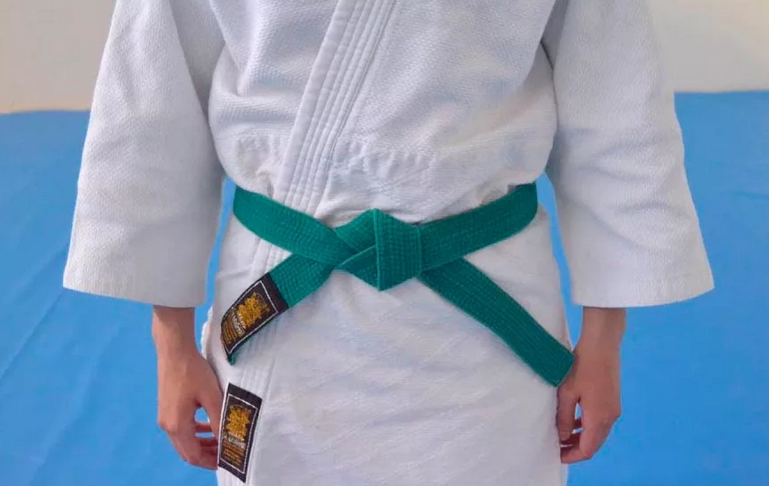
Variation 2:
- Repeat the first paragraph of the previous methodology.
- Attach to the waist and slightly stretch.
- Scroll through the waist. The ends appear in the front.
- Hold the belt at the seams. Ride one tip under another and a strip on the belly, forming a loop.
- Pass the other into it and tighten it. If everything is done correctly, you get a flat result.
Now let's move on to the varieties of hand -to -hand combat and the specifics of the bandage of the “tape”.
How to tie a kimono belt for karate: Instructions, video
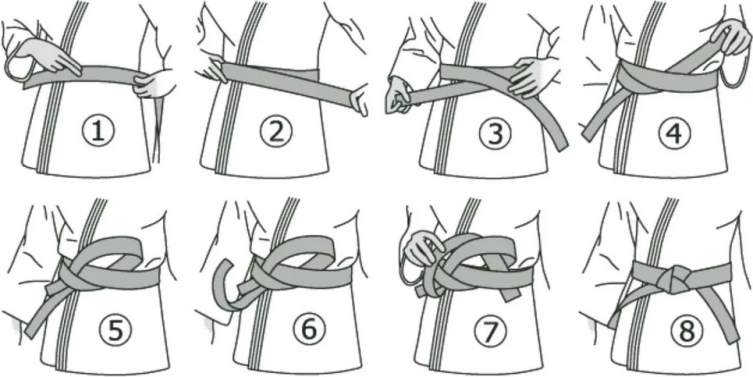
We present a universal method that is suitable for both adults and children. How to tie a kimono belt for karate. Here's the instruction:
- Part of the tape is a short end (approximately 30-40 cm) Attach to the waist.
- Make others 2 turns Around the body. Moreover, the layers should be on each other.
- Pick up two layers from the bottom of the upper area.
- Tighten.
- The tips should also be identical visually.
By the way, in different types of karate there are specific nuances. So, in variation kyokushinkai Offends not for 2 halves, but with a displacement. More details in the photo instructions below.
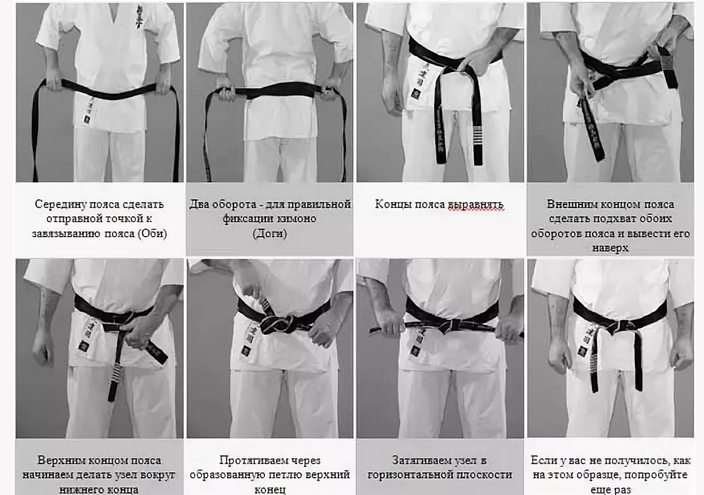
And in shotokan - The knot is made even easier: 3 points of classical technology are repeated and tips are tightened. This can be seen in the picture below:
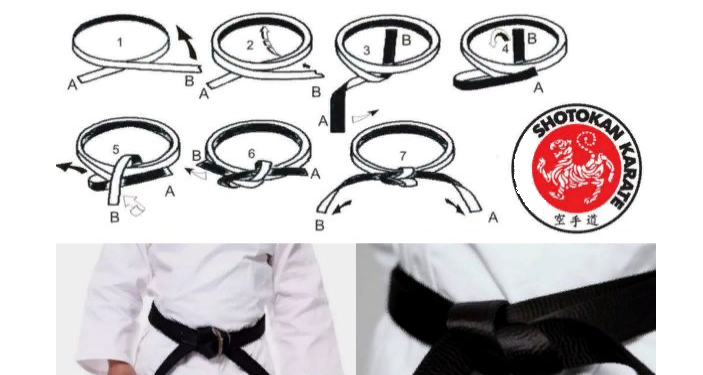
Watch more in the video:
Video: How to tie a belt for karate?
How to tie a belt on a kimono for judo: Instruction

Judo uses classic technique. It is worth paying close attention to the following moment: the knot should be strictly in the central part, the ends of the same length and the result does not interfere with the training. Here is the instruction how to properly tie a belt on a kimono for judo:
- Fold the “tape” in half, thereby noting the middle.
- Attach to the waist area, pull.
- Scroll around the belt area. The tips should appear in front.
- Hold the belt at the seams. Stick one under the other, forming a loop.
- Pass the other into it and tighten it.
Watch more in the video. Below is described even more techniques.
Video: How to tie a belt in judo? How to tie a belt on a kimono for judo?
Tie a kimono belt in aikido: how correctly, instruction, video

You can tie a kimono belt for aikido with two options. How to do this correctly, you will see in the photo above. This is the first option - instructions:
- From the left edge of the belt, retreat approximately 20 cm, press it to the body in front, in the waist.
- With the right hand 2 timeswithout twisting, wrap it around the waist. It is important that the movement of the belt is carried out from the left side of the body to the right along the stomach.
- Then go to your back and take the belt from under the left hand.
- The top of the missing from below enter the part back between 2 parts Around the waist.
- Leave it from above from it not a tightened loop into which you enter the other part in the direction from top to bottom. At the same time, skip the edge not only into the loop, but also between the two layers of the belt.
- After that, gently pull the edges, thereby forming a knot. Ready.
Another option:
- Repeat 1-3 paragraph of the previous algorithm.
- Throw it to your right hand and wrap it again.
- Make the second round in the same way. Ideally, he should lie on top of the first.
- Skip the free part under the Ob from the bottom up.
- Then tie the ends with the usual knot.
The disadvantages of this option are the free parts of the tape. But such an alternative allows you to get a knot that is not untied during training sessions and even more so - struggle.
Video: How to tie a belt in Aikido?
How to tie a belt on a kimono for sambo: Instruction
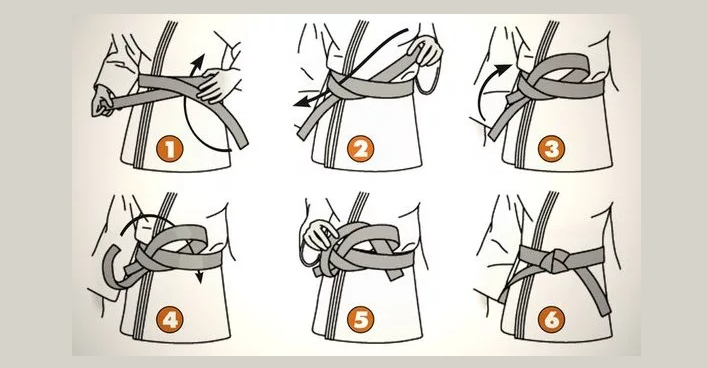
The technology is similar to the classic variation, which is described above. It is important to observe all points of the instructions. Ideally, a dense and flat knot with identical ends. How to tie a belt on a kimono for sambo?
- Fold the belt in two halves, determining the middle.
- Attach to the waist, stretch your hands, as if straightening around.
- Check the "tape" near the waist. The ends of the tape are in front.
- Hold the belt at the seams. Swell the first end under another. A loop is formed.
- Pass the tip of the belt on the other side and tighten it well.
Look again in the video how to do it correctly:
Video: How to tie a belt for sambo?
How to tie a belt on a kimono for kudo: instruction
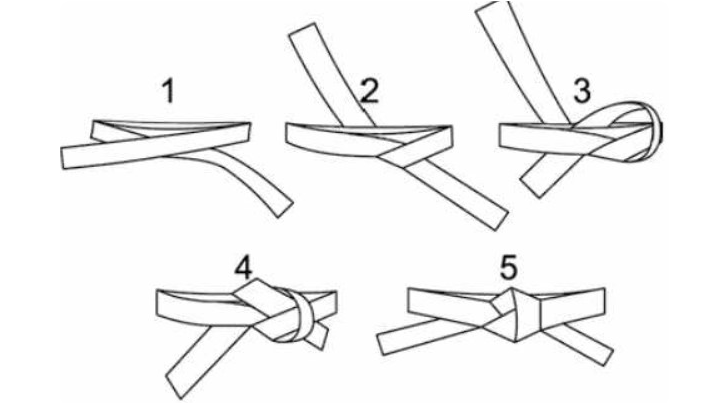
Kudo ribbons have strict parameters. Their width - 4 cm, and the length can be different. By the way, the color scheme and the number of stripes are individually. As a rule, they depend on the level of acquired skills of a student or master. How to tie a belt on a kimono for kudo? Instructions:
- Find the middle of the tape and fix it in the waist.
- Wrap around her once. The ends are behind.
- Give them ahead other turn.
- The right tip of the belt should be below the curls, draw it to the top.
- Direct down. Take it for him.
- Direct the other tip of the tape. Make sure that the tape does not twist.
- Insert the last part of the tape into the resulting loop, and then into the upper curl. Pull both tip. It turns out a tight seal. Ready.
Video: How to tie a belt in Kudo?
A belt is an important element for a fighter of oriental fights and battles. He shows the whole life of the fighter's philosophy. That is why each training begins with the correct technique of executing the node. Although for different types of power sports there are unique methods, fighters should know them. Good luck!







